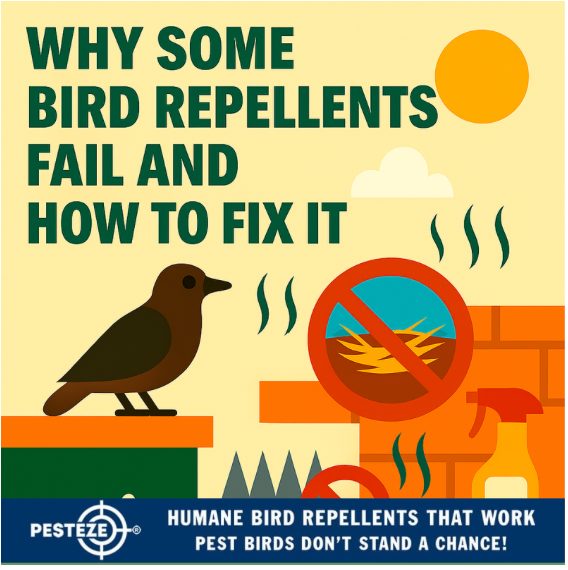WHY SOME BIRD REPELLENTS FAIL AND HOW TO FIX IT

WHY SOME BIRD REPELLENTS FAIL AND HOW TO FIX IT
SUMMARY
Bird repellent strategies often fall short of expectations, leaving homeowners frustrated and properties vulnerable to avian intrusions. This comprehensive guide reveals the critical reasons behind ineffective bird control and provides innovative solutions for 2025.
FEATURES
- Scientific Analysis: In-depth examination of why traditional bird repellent methods consistently underperform in real-world scenarios.
- Adaptive Strategies: Cutting-edge approaches that address the limitations of conventional bird deterrent techniques.
- Behavioral Insights: Understanding bird intelligence and adaptation mechanisms that render many repellent methods ineffective.
- Technological Innovation: Advanced solutions that leverage modern science and technology to create more effective bird control.
- Cost-Effective Solutions: Practical, long-term strategies that provide sustainable and economical bird management.
GUIDE DESCRIPTION
Bird repellent failures are a complex issue rooted in multiple scientific and environmental factors. Traditional methods often fall short because they fail to understand the sophisticated adaptive capabilities of bird populations. Birds possess remarkable intelligence, quickly learning to circumvent or ignore standard deterrent techniques that might initially seem promising.
Many homeowners invest significant resources in bird repellent solutions without understanding the underlying biological and behavioral mechanisms that render these methods ineffective. The most common pitfalls include predictable deterrent patterns, lack of environmental context, and failure to address the root causes of bird attraction to specific areas.
The effectiveness of bird repellents depends on a nuanced understanding of avian behavior, habitat preferences, and environmental conditions. Simply deploying a single technology or method rarely provides comprehensive protection. Instead, a multi-layered, adaptive approach is necessary to create genuinely effective bird management strategies.
Environmental factors play a crucial role in repellent success. Urban landscapes, seasonal changes, food availability, and local bird species characteristics significantly impact the effectiveness of any deterrent strategy. What works in one location may prove completely ineffective in another, highlighting the need for tailored, context-specific solutions.
Modern bird control requires an integrated approach that combines multiple technologies and strategies. Ultrasonic devices, visual deterrents, physical barriers, and behavioral modification techniques must be carefully selected and implemented based on specific environmental conditions and bird species characteristics.
Technological advancements in 2025 offer unprecedented opportunities for more sophisticated bird repellent solutions. Machine learning algorithms, adaptive sensor networks, and AI-powered detection systems can now create dynamic, responsive bird management strategies that evolve in real-time.
Successful bird repellent strategies demand continuous monitoring, adaptation, and a holistic understanding of avian behavior. Homeowners and property managers must be prepared to adjust their approaches, combining multiple technologies and maintaining a proactive, informed approach to bird control.
- Pukhraj Sharma


Comments 0